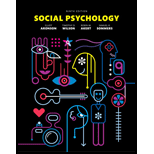
Introduction
The propinquity effect is simply the positive relationship between proximity and attraction. In short, the more often you see someone the more likely you are to be attracted to them. This attraction can be romantic or sexual, but it need not be. It can easily take the form of friendships and trust among neighbors. Functional distance also plays an important role. People who are brought together by geographical or architectural circumstances also feel this closeness, even though they may not live or work in close proximity to one another.
Explanation of Solution
Correct answer and explanation
In this case, the correct answer is option (B). Marge works near the elevator and the kitchen. This likely brings her into contact with a large number of her co-workers every day. The propinquity effect tells us that this would likely make her very popular. Her colleagues see her often, which leads to a feeling of attraction and emotional closeness.
Explanations for incorrect options
Option (A) refers to Bart, who doesn't like his neighbor. The late-night music and Bart's difficulty with sleeping would lead to animosity, which would create a NEGATIVE relationship between the proximity and attraction of the two neighbors. As the propinquity effect refers to a positive relationship, this cannot be the correct choice.
Option (C) refers to Homer, who prefers to avoid running into people he may not want to interact with. This avoidance of interaction does not allow the propinquity effect to take place.
Option (D) refers to Lisa, who didn't make as many friends in her freshman year as she did her sophomore year. Although the architectural circumstances (for instance, where her room was located) may have had some effect on this, we simply do not have enough information to attribute this to functional distance. There are any number of factors which may have played a part in this.
Want to see more full solutions like this?
Chapter 10 Solutions
Social Psychology (9th Edition)
- humanized short answers- What strategies could be used to help students with hearing loss to access the curriculum? What strategies can be used to help students with hearing loss be a part of the classroom community?arrow_forwardshort simple humanized answer each- How did the field of deaf education evolve, and what is the history of the debate between oral and manual communication? How are the terms deaf and hard of hearing defined? What are some characteristics of children with hearing difficulties, and why must we consider the degree, type, and age of onset of the hearing loss? What are some causes of hearing loss? How is hearing loss detected, and why is early intervention so critical? How can varying hearing levels affect a student’s cognitive, academic, social, and language development, and what can be done to maximize a student’s communication potential? What kinds of educational responses are needed for students who are deaf and hard of hearing?arrow_forwardShould U.S. foreign policy include provisions for reducing poverty in other nations of the world? Should U.S. domestic policy include provisions for reducing poverty in the United States? How are these issues similar? How are they different?arrow_forward
- Discuss Chapter 1 of Barry Glassner’s “The Culture of Fear.” Student’s may address but are not limited to discussing how the media uses individual scenarios to falsely give a wider perception of some kind, the media’ use of exaggerations and assertions and the financing of fear.arrow_forwardTake something (physical, personal or social) and change it. Tell us, what you started out with, what it looked like after you changed it, and what you did to make the change.arrow_forwardhumanized answers and couple of sentences for each: How did the field of gifted education evolve, and why is it important for giftedness to be recognized as an exceptionality? How do we define “gifts and talents,” and how are students identified? What are some characteristics of students with gifts and talents, and how can the information processing model (IPM) help us understand their needs? Why do students from culturally and linguistically different or socioeconomically disadvantaged homes and twice exceptional student continue to be under-identified for gifted-educational supports and services? What educational responses are needed to address the strengths and challenges of students with gifts and talents? What life course considerations are important for students with gifts and talents?arrow_forward
- Explain how bilingualism, monolingualism, or trilingualism has affected you while using language in the Miami areaarrow_forwardDescribe the two models of language processingarrow_forward2. How would you compare the lives of poor people living in the low-income nations of the world with those in cities and rural areas of the United States? In what ways are their lives similar? In what ways are they different?arrow_forward
 Social Psychology (10th Edition)SociologyISBN:9780134641287Author:Elliot Aronson, Timothy D. Wilson, Robin M. Akert, Samuel R. SommersPublisher:Pearson College Div
Social Psychology (10th Edition)SociologyISBN:9780134641287Author:Elliot Aronson, Timothy D. Wilson, Robin M. Akert, Samuel R. SommersPublisher:Pearson College Div Introduction to Sociology (Eleventh Edition)SociologyISBN:9780393639407Author:Deborah Carr, Anthony Giddens, Mitchell Duneier, Richard P. AppelbaumPublisher:W. W. Norton & Company
Introduction to Sociology (Eleventh Edition)SociologyISBN:9780393639407Author:Deborah Carr, Anthony Giddens, Mitchell Duneier, Richard P. AppelbaumPublisher:W. W. Norton & Company The Basics of Social Research (MindTap Course Lis...SociologyISBN:9781305503076Author:Earl R. BabbiePublisher:Cengage Learning
The Basics of Social Research (MindTap Course Lis...SociologyISBN:9781305503076Author:Earl R. BabbiePublisher:Cengage Learning Criminalistics: An Introduction to Forensic Scien...SociologyISBN:9780134477596Author:Saferstein, RichardPublisher:PEARSON
Criminalistics: An Introduction to Forensic Scien...SociologyISBN:9780134477596Author:Saferstein, RichardPublisher:PEARSON Sociology: A Down-to-Earth Approach (13th Edition)SociologyISBN:9780134205571Author:James M. HenslinPublisher:PEARSON
Sociology: A Down-to-Earth Approach (13th Edition)SociologyISBN:9780134205571Author:James M. HenslinPublisher:PEARSON Society: The Basics (14th Edition)SociologyISBN:9780134206325Author:John J. MacionisPublisher:PEARSON
Society: The Basics (14th Edition)SociologyISBN:9780134206325Author:John J. MacionisPublisher:PEARSON





